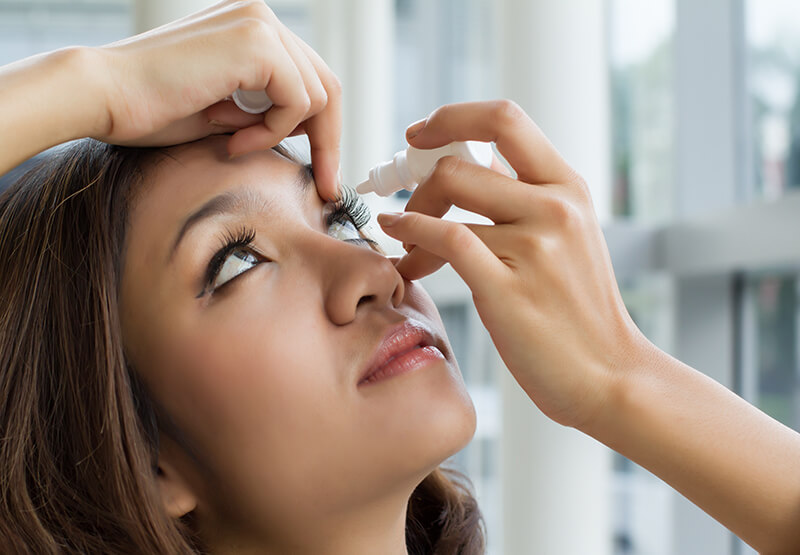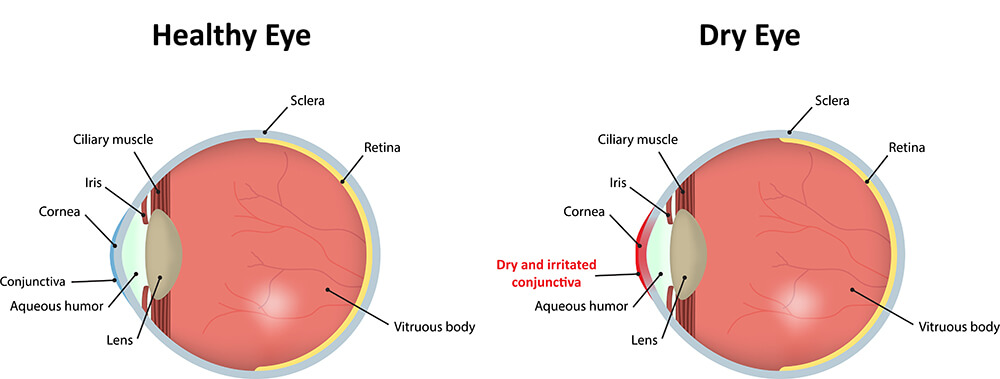What is dry eye?
Dry eye happens when your eyes don’t make enough tears to stay wet, or when your tears don’t work correctly. This can make your eyes feel uncomfortable, and in some cases it can also cause vision problems. Dry eye is common — it affects millions of Americans every year. The good news is that if you have dry eye, there are lots of things you can do to keep your eyes healthy and stay comfortable.
What are the symptoms of dry eye?
Dry eye can cause:
- A scratching feeling, like there’s something in your eye
- Stinging or burning feelings in your eye
- Red eyes
- Sensitivity to light
- Blurry vision
Am I at risk for dry eye?
Anyone can get dry eye, but you might be more likely to have dry eye if you:
- Are age 50 or older
- Are female
- Wear contact lenses
- Don’t get enough vitamin A (found in foods like carrots, broccoli, and liver) or omege-3 fatty acids (found in fish, walnuts, and vegetable oils)
- Have certain autoimmune conditions, like lupus or Sjögren syndrome
What causes dry eye?
Normally, glands above your eyes make tears that keep your eyes wet. Dry eye happens when your tears don’t do their job. This could mean:
- Your glands don’t make enough tears to keep your eyes wet
- Your tears dry up too fast
- Your tears just don’t work well enough to keep your eyes wet
How can I check for dry eyes?
Your doctor at Fogg Remington EyeCare can check for dry eye as part of a comprehensive dilated eye exam. The exam is simple and painless — your doctor will give you some eye drops to dilate (widen) your pupil and then check your eyes for dry eye and other eye problems.
Be sure to tell your doctor if you think you might have dry eye. To find out if you have dry eye, your doctor might check:
- The Amount of tears your eyes make
- How long it takes for your tears to dry up
- The structure of your eyelids
What’s the treatment for dry eye?
Treatment for dry eye usually depends on what’s causing your symptoms. There are a few different types of treatment that can ease your symptoms and help keep your eyes healthy.
Over-the-counter eye drops. The most common treatment for mild dry eye is a type of eye drops called artificial tears. You can get these eye drops without a prescription. There are also over-the-counter moisturizing gels and ointments that may help your eyes feel better.
Prescription medicines. If your dry eye is more serious, your eye doctor may give you a prescription for medicines called cyclosporine (Restasis) or lifitegrast (Xiidra). These medicines are both types of eye drops that can help your eyes make more tears.
Lifestyle changes. If something in your life or your environment is causing your dry eye, or making it worse, your doctor may suggest changes to help protect your eyes.
For example, if a medicine you take for another health condition is causing dry eye, your doctor may also suggest that you try a different medicine.
Your eyes may also feel better if you:
- Try to avoid smoke, wind, and air conditioning
- Use a humidifier to keep the air in your home from getting too dry
- Limit screen time and take breaks from staring at screens
- Wear wraparound sunglasses when you’re outside
- Drink plenty of water – try for 8-10 glasses every day
- Get enough sleep – about 7-8 hours a night
Tear duct plugs. If tears are draining too quickly from your eyes, your doctor may suggest putting special plugs (called punctal plugs) in your tear ducts (small holes in the inner corners of your eyes). These plugs can help keep your tears in your eyes.
Surgery. In some cases, dry eye can happen because your lower eyelids are too loose, causing tears to drain too quickly out of your eye. If this is the cause of your dry eye, your eye doctor may suggest surgery to fix your eyelids and help your tears stay on your eyes. This treatment is not very common.
Request an Appointment
To schedule your appointment at Fogg Remington EyeCare, please call 559-449-5010 or click the button below.










